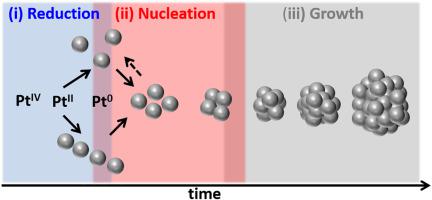Advances in Colloid and Interface Science ( IF 15.6 ) Pub Date : 2020-10-31 , DOI: 10.1016/j.cis.2020.102300 Jonathan Quinson , Kirsten M.Ø. Jensen

|
Platinum (Pt) is one of the most studied materials in catalysis today and considered for a wide range of applications: chemical synthesis, energy conversion, air treatment, water purification, sensing, medicine etc. As a limited and non-renewable resource, optimized used of Pt is key. Nanomaterial design offers multiple opportunities to make the most of Pt resources down to the atomic scale. In particular, colloidal syntheses of Pt nanoparticles are well documented and simple to implement, which accounts for the large interest in research and development. For further breakthroughs in the design of Pt nanomaterials, a deeper understanding of the intricate synthesis-structures-properties relations of Pt nanoparticles must be obtained. Understanding how Pt nanoparticles form from molecular precursors is both a challenging and rewarding area of investigation. It is directly relevant to develop improved Pt nanomaterials but is also a source of inspiration to design other precious metal nanostructures. Here, we review the current understanding of Pt nanoparticle formation. This review is aimed at readers with interest in Pt nanoparticles in general and their colloidal syntheses in particular. Readers with a strongest interest on the study of nanomaterial formation will find here the case study of Pt. The preferred model systems and characterization techniques used to perform the study of Pt nanoparticle syntheses are discussed. In light of recent achievements, further direction and areas of research are proposed.
中文翻译:

从分子中的铂原子到胶体纳米粒子:还原,成核和生长机理的综述
铂(Pt)是当今催化研究最深入的材料之一,被认为具有广泛的用途:化学合成,能量转换,空气处理,水净化,传感,医药等。作为有限且不可再生的资源,已对其进行了优化Pt的使用是关键。纳米材料设计提供了许多机会,可以充分利用Pt资源,直至达到原子级。尤其是,Pt纳米颗粒的胶体合成已得到充分证明,并且易于实现,这引起了研究和开发的极大兴趣。为了在Pt纳米材料的设计上取得进一步的突破,必须对Pt纳米颗粒的复杂的合成,结构,性能关系有更深入的了解。理解Pt纳米颗粒如何从分子前体形成是一个充满挑战和收获的领域。开发改良的Pt纳米材料直接相关,但也启发了设计其他贵金属纳米结构的灵感。在这里,我们回顾当前对Pt纳米颗粒形成的理解。本文针对的是一般对Pt纳米颗粒特别是其胶体合成感兴趣的读者。对纳米材料形成研究最感兴趣的读者将在此找到Pt的案例研究。讨论了用于进行Pt纳米颗粒合成研究的优选模型系统和表征技术。根据最近的成就,提出了进一步的研究方向和领域。开发改良的Pt纳米材料直接相关,但也启发了设计其他贵金属纳米结构的灵感。在这里,我们回顾当前对Pt纳米颗粒形成的理解。本文针对的是一般对Pt纳米颗粒特别是其胶体合成感兴趣的读者。对纳米材料形成研究最感兴趣的读者将在此找到Pt的案例研究。讨论了用于进行Pt纳米颗粒合成研究的优选模型系统和表征技术。根据最近的成就,提出了进一步的研究方向和领域。开发改良的Pt纳米材料直接相关,但也启发了设计其他贵金属纳米结构的灵感。在这里,我们回顾当前对Pt纳米颗粒形成的理解。这篇综述针对的是一般对Pt纳米粒子特别是其胶体合成感兴趣的读者。对纳米材料形成研究最感兴趣的读者将在此找到Pt的案例研究。讨论了用于进行Pt纳米颗粒合成研究的优选模型系统和表征技术。根据最近的成就,提出了进一步的研究方向和领域。这篇综述针对的是一般对Pt纳米粒子特别是其胶体合成感兴趣的读者。对纳米材料形成研究最感兴趣的读者将在此找到Pt的案例研究。讨论了用于进行Pt纳米颗粒合成研究的优选模型系统和表征技术。根据最近的成就,提出了进一步的研究方向和领域。本文针对的是一般对Pt纳米颗粒特别是其胶体合成感兴趣的读者。对纳米材料形成研究最感兴趣的读者将在此找到Pt的案例研究。讨论了用于进行Pt纳米颗粒合成研究的优选模型系统和表征技术。根据最近的成就,提出了进一步的研究方向和领域。



























 京公网安备 11010802027423号
京公网安备 11010802027423号